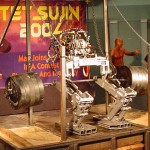Archive for Ноябрь, 2004
Tetsujin- тяжелая атлетика экзоскелетов.
- Тип контента: Новостная статья
- Номер документа: 4771
- Название документа: RoboNexus 2004
- Номер (DOI, IBSN, Патент): Не заполнено
- Изобретатель/автор: Не заполнено
- Правопреемник/учебное заведение: Не заполнено
- Дата публикации документа: 2004-11-29
- Страна опубликовавшая документ: Россия
- Язык документа: Русский
- Наименование изделия: Не заполнено
- Источник: http://www.3dnews.ru/editorial/robonexus
- Вложения: Не заполнено
- Аналитик: Helix
 Как новинку в рамках RoboNexus 2004 стоит отметить появление новых соревнований — Tetsujin Bionic Weight-Lifting Competition. «Tetsujin» в переводе с японского «железный человек», а одноименные состязания напоминали игры по поднятию тяжестей среди экзоскелетов (специальных устройств, улучшающих механические возможности тела человека).
Как новинку в рамках RoboNexus 2004 стоит отметить появление новых соревнований — Tetsujin Bionic Weight-Lifting Competition. «Tetsujin» в переводе с японского «железный человек», а одноименные состязания напоминали игры по поднятию тяжестей среди экзоскелетов (специальных устройств, улучшающих механические возможности тела человека).
Категория: Продвижение | Нет комментариев »
Design of a Spatial Linkage Haptic Interface
- Тип контента: Научная статья
- Номер документа: 6827
- Название документа: Design of a Spatial Linkage Haptic Interface
- Номер (DOI, IBSN, Патент): Не заполнено
- Изобретатель/автор: Kevin Lin, H. Kazerooni, Ronald M. Chung, John Ryan Steger
- Правопреемник/учебное заведение: Department of Mechanical Engineering University of California
- Дата публикации документа: 2004-11-19
- Страна опубликовавшая документ: США
- Язык документа: Английский
- Наименование изделия: Не заполнено
- Источник: Proceedings of IMECE2004 2004 ASME International Mechanical
- Вложения: Да
- Аналитик: Глаголева Елена
 This paper describes the mechanical and electrical design of a compact high fidelity desktop haptic interface that provides three-degree-of-freedom point-force interaction through a handheld pen-like stylus. The complete haptic device combines a spatial linkage, actuation, power amplification, and control electronics in a standalone package with a footprint similar to that of a notebook computer (33cm x 25cm x 10cm). The procedure used to design the statically balanced spatial linkage is explained and both an inexpensive lightweight plastic version and a high stiffness, high strength, aluminum and stainless steel version are presented. The theory and implementation of sinusoidal encoder interpolation and sinusoidal servo-motor commutation used to achieve high-fidelity haptic simulation is covered for two versions of electronic control hardware: custom hardware based on a digital signal processor (DSP) and an off-the-shelf design based on an embedded PC.
This paper describes the mechanical and electrical design of a compact high fidelity desktop haptic interface that provides three-degree-of-freedom point-force interaction through a handheld pen-like stylus. The complete haptic device combines a spatial linkage, actuation, power amplification, and control electronics in a standalone package with a footprint similar to that of a notebook computer (33cm x 25cm x 10cm). The procedure used to design the statically balanced spatial linkage is explained and both an inexpensive lightweight plastic version and a high stiffness, high strength, aluminum and stainless steel version are presented. The theory and implementation of sinusoidal encoder interpolation and sinusoidal servo-motor commutation used to achieve high-fidelity haptic simulation is covered for two versions of electronic control hardware: custom hardware based on a digital signal processor (DSP) and an off-the-shelf design based on an embedded PC.
Категория: Научные статьи | Нет комментариев »
Design of Haptic Arm Exoskeleton For Training and Rehabilitation
- Тип контента: Научная статья
- Номер документа: 7091
- Название документа: Design of Haptic Arm Exoskeleton For Training and Rehabilitation
- Номер (DOI, IBSN, Патент): Не заполнено
- Изобретатель/автор: Abhishek Gupta, Marcia K. O’Malley
- Правопреемник/учебное заведение: Mechatronics and Haptic Interfaces Laboratory Department of Mechanical Engineering Rice University Houston, Texas
- Дата публикации документа: 2004-11-19
- Страна опубликовавшая документ: США
- Язык документа: Английский
- Наименование изделия: Не заполнено
- Источник: Proceedings of IMECE’04 2004 ASME International Mechanical
- Вложения: Да
- Аналитик: Глаголева Елена
 A high-quality haptic interface is typically characterized by low apparent inertia and damping, high structural stiffness, minimal backlash and absence of mechanical singu-larities in the workspace. In addition to these specifications, exoskeleton haptic interface design involves consideration of additional parameters and constraints including space and weight limitations, workspace requirements and the kinematic constraints placed on the device by the human arm. In this context, we present the design of a five degree-of-freedom haptic arm exoskeleton for training and rehabi-litation in virtual environments. The design of the device, including actuator and sensor selection, is discussed. Limitations of the device that result from the above selections are also presented. The device is capable of providing kinesthetic feedback to the joints of the lower arm and wrist of the operator, and will be used in future work for robot-assisted rehabilitation and training.
A high-quality haptic interface is typically characterized by low apparent inertia and damping, high structural stiffness, minimal backlash and absence of mechanical singu-larities in the workspace. In addition to these specifications, exoskeleton haptic interface design involves consideration of additional parameters and constraints including space and weight limitations, workspace requirements and the kinematic constraints placed on the device by the human arm. In this context, we present the design of a five degree-of-freedom haptic arm exoskeleton for training and rehabi-litation in virtual environments. The design of the device, including actuator and sensor selection, is discussed. Limitations of the device that result from the above selections are also presented. The device is capable of providing kinesthetic feedback to the joints of the lower arm and wrist of the operator, and will be used in future work for robot-assisted rehabilitation and training.
Категория: Научные статьи | Нет комментариев »
High Speed Ring-Based Distributed Networked Control System for Real-Time Multivariable Applications
- Тип контента: Научная статья
- Номер документа: 7291
- Название документа: High Speed Ring-Based Distributed Networked Control System for Real-Time Multivariable Applications
- Номер (DOI, IBSN, Патент): Не заполнено
- Изобретатель/автор: Sunghoon Kim, H. Kazerooni
- Правопреемник/учебное заведение: University of California, Berkeley
- Дата публикации документа: 2004-11-19
- Страна опубликовавшая документ: США
- Язык документа: Английский
- Наименование изделия: Не заполнено
- Источник: 2004 ASME International Mechanical Engineering Congress and
- Вложения: Да
- Аналитик: Глаголева Елена
 A networked control system (NCS) is a control architecture where sensors, actuators and controllers are distributed and interconnected. It is advantageous in terms of interoperability, expandability, installation, volume of wiring, maintenance, and cost-effectiveness. Many distributed network systems of various topologies and network types have been developed, but NCS systems tend to suffer from such issues as nondeterminism, long network delays, large overheads and unfairness. This paper presents the ring-based protocol, called the ExoNet, and its network architecture which are built to achieve better performance as a distributed networked system. A Cypress transceiver CY7C924ADX is applied to the network as a communication unit. The protocol is based on the transceiver and developed to achieve fast communication and allowable latency for controls with high control loop frequency. Compared with other standard network types such as Ethernet, ControlNet or DeviceNet, the network is characterized by its ring-based architecture, simple message and packet formats, one-shot distribution of control data and collection of sensor data, multi-node transmission, echo of a message, and other features. The network also guarantees determinism, collision-free transmission, relatively small overhead, fairness between nodes and flexibility in configuration. Its analysis and comparison with these network types are also provided and its application on the Berkeley Lower-Extremity Exoskeleton (BLEEX) is described.
A networked control system (NCS) is a control architecture where sensors, actuators and controllers are distributed and interconnected. It is advantageous in terms of interoperability, expandability, installation, volume of wiring, maintenance, and cost-effectiveness. Many distributed network systems of various topologies and network types have been developed, but NCS systems tend to suffer from such issues as nondeterminism, long network delays, large overheads and unfairness. This paper presents the ring-based protocol, called the ExoNet, and its network architecture which are built to achieve better performance as a distributed networked system. A Cypress transceiver CY7C924ADX is applied to the network as a communication unit. The protocol is based on the transceiver and developed to achieve fast communication and allowable latency for controls with high control loop frequency. Compared with other standard network types such as Ethernet, ControlNet or DeviceNet, the network is characterized by its ring-based architecture, simple message and packet formats, one-shot distribution of control data and collection of sensor data, multi-node transmission, echo of a message, and other features. The network also guarantees determinism, collision-free transmission, relatively small overhead, fairness between nodes and flexibility in configuration. Its analysis and comparison with these network types are also provided and its application on the Berkeley Lower-Extremity Exoskeleton (BLEEX) is described.
Категория: Научные статьи | Нет комментариев »
Статистика
Категорий: 179
Статей всего: 2,003
По типу:
Видео: 36
Выдержка с форума: 1
Контактные данные: 12
Научная статья: 1388
Не заполнено: 5
Новостная статья: 317
Обзор технологии: 42
Патент: 219
Тех.подробности: 34
Тип: 1
Комментариев: 6,226
Изображений: 3,005
Подробней...
ТОР 10 аналитиков
-
Глаголева Елена - 591
Дмитрий Соловьев - 459
Helix - 218
Ридна Украина))) - 85
Наталья Черкасова - 81
max-orduan - 29
Елена Токай - 15
Роман Михайлов - 9
Мансур Жигануров - 4
Дуванова Татьяна - 3
Календарь
Авторизация
Ошибка в тексте?
Выдели её мышкой!
И нажми Ctrl+Enter